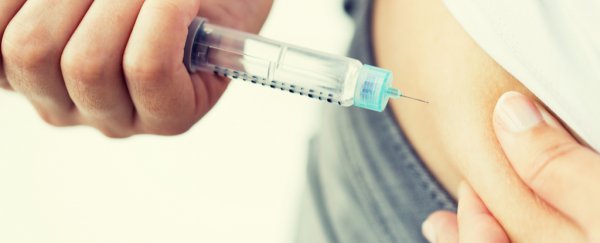To control their blood sugar levels, people with type 2 diabetes constantly need to rely on medication, but it's a tricky condition to manage, especially if you need daily insulin shots.
Researchers have been working on a new method for delivering diabetes drugs to make them last longer in the body. Now a recent study using both mice and monkeys has shown potential for treatments that would only require a couple of injections a month.
Some of the latest-generation type 2 diabetes drugs contain a molecule called GLP1 (glucagon-like peptide-1), which stimulates insulin production in the body only when it needs more glucose.
That sounds ideal, but unfortunately, GLP1 has a really short half-life - it breaks down in the body quickly, making it an impractical long-term treatment on its own.
By combining it with other molecules, it's possible to extend the half-life of GLP1. But that method still only gets us to about 3-7 days.
Right now, patients in the US already have some options that can be injected weekly, but scientists are looking for a way to slow down the release of the drug itself.
Now a team from Duke University has managed to combine GLP1 with a biopolymer molecule that starts out as a liquid in colder temperatures, but thickens into a gel-like substance in reaction to body heat.
This means the solution can be administered with a simple injection, but once it gets into the body, the drug is released very slowly, so it can control blood glucose levels for longer with just one dose.
To test how their new solution would work for actual diabetes treatment, the researchers tried the drug in both mice and in rhesus monkeys - two species with well-established diabetes models.
They got exciting results in both: in mice, the new GLP1 solution controlled glucose levels for 10 days after just one injection; in monkeys, whose metabolism is slower, the effects lasted up to 17 days.
More than two weeks for one injection is better than any diabetes drug currently on the market.
The team thinks that because human metabolism is even slower than in monkeys, theoretically the drug could last longer in people, perhaps requiring just one injection a month.
"Preclinical data presents compelling evidence that this construct would require no more than two injections a month for humans, and possibly as few as one per month, especially given the dose-stacking potential of this system," the researchers write in the paper.
The team thinks their new approach to 'trapping' GLP1 in the gel-like substance could be applied to other types of medication, too.
Of course, it's important to note that so far the method has only worked in animal studies, and scientists will need to do more research to see how the principles would translate to human use.
GLP1-based medications are currently not the first-line treatment for people with type 2 diabetes, but this sounds like an exciting step towards making diabetes management easier for many.
The study was published in Nature Biomedical Engineering.
